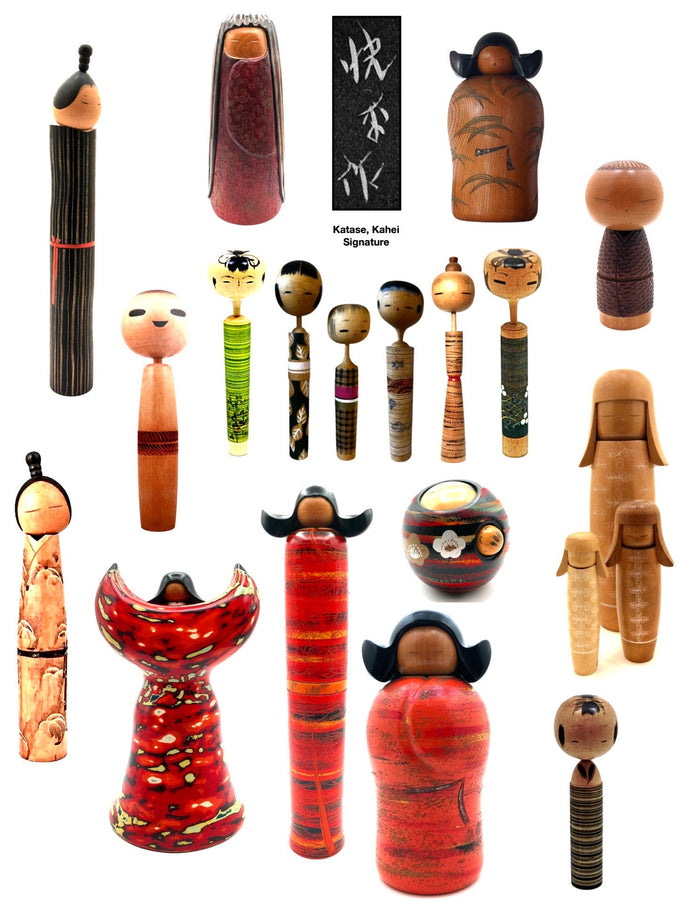


Vintage Sosaku Kokeshi entitled: “Ei | Brilliant” by Katase, Kaihei (1921-2015)
Dimensions: 10-00”h
This “one-off” creation is truly an exceptional, three-dimensional form, all lathe-turned, which is a feat unto itself, with hand-crafted details and finish. The focus of this doll is the brilliant vermilion red wedding Kimono, with irregular oil and water motifs of yellow, turquoise, and black lacquer. Her arms are raised as if welcoming guests with respect and courtesy. Her head is small compared to her overall body, with black, unbound flowing hair, (Heian styling), falling down the sides of her face. This hairstyle was said to intensify spiritual energy and beauty, as well as being a mark of elevated rank. Her neck is covered by a white “Juban” collar, (Kurotomesode), which defines the most formal type of kimono for married women. Her eyes are not painted, but carved into the wood, and she has a tiny red dot for a nose. Having been made for a special customer, the piece is signed in red Kanji on the bottom, along with the doll’s name. Art objects at this time were not necessarily signed because they were made for domestic customers, and the artist was known throughout every prefecture throughout Japan. Signatures became popular, and required when international business was established.)
This piece was recognized as a “Prime Minister” award winner appearing in their first Kokeshi Art Exhibition catalog. The piece was also included in the 2022 publication of Sosaku Kokeshi: Celebrating the Major Artists of the Creative Movement. For more information on this artist go to the following link: https://mingeiarts.com/collections/artisan-woodworker-katase-kahei-1922-2015.
Condition: Superb, outstandingly excellent, impressive, and beautiful. We have not seen another in 30 years of collecting Sosaku Kokeshi. No chips, cracks, breaks, missing pieces, or restoration, and retains its original details and finish. The piece meets all the standards of the vintage collectible Sosaku Kokeshi.

Artisan
Woodworker: Katase, Kahei
1922-2015
Biographical History:
Katase-san was born in Kanazawa prefecture in 1921 in a region known for its beautiful wooden marquetry crafts. Katase-san, the son of a Kijishi, (woodworker), began making creative Kokeshi in 1946. He won the first Prime Minister’s Award in 1954 at the ‘All Nippon Kokeshi Competition’. Along with many of his fellow Sosaku artists, Katase-san was a soldier and perhaps turned to creative Kokeshi-making to assuage the rigors of a long-fought war. Since 1962, he served as a judge at the Kokeshi Contest in Japan. In 1955, his work was dedicated to Her Majesty the Empress. In 1970 he was awarded the holder of Excellent Technique and was named a member of Meiko-Kai. He went to the United States in 1973 to direct the overseas exhibition in St Louis, where he was introduced through a television program at Missouri State. He was a member of the Cultural Properties Protection Committee of Hakone Town and a member of the Nippon Kokeshi Artistic Handicraft Association.
Collector's note – descriptive qualities, standard characteristics & ornamentation styles:
Many of his pieces are differently treated, with the natural contrasting head, and the natural grooved and stained body. He illustrates obi, inset into the doll with a hemp motif, (In early times, “asa” was an important source of cloth, and hemp leaves themselves formed the basis of a variety of hemp patterns). History tells us that the ‘God of Hemp’ is revered at Oasahiko Shrine in Tokushima. He additionally renders spring with cherry blossoms, wheat, trees, and stars to give character to his dolls. He seems to enjoy the rendering of long flowing unbound hair, (taregami) and details such as the inlay of silver motifs on the body.
And finally, it is unusual to see a doll made of three bulbous forms that compose the body and head, utilizing different woods to express the desired detail.
Katase focuses on what is known as “one-off” dolls turned from one piece of wood and detailed throughout the figural form. They primarily illustrate the “new” styles of Japan of the 18th century when the Dutch East Indies Trading Company influenced Japanese everyday life and customs. Katase-san is a master of lacquered color finishes incorporated with detailed carving of elements in the natural environment. Buddhist figures, which are intricately carved, are another style by this artist.
Explore & Learn More about Woodworker: Katase, Kahei